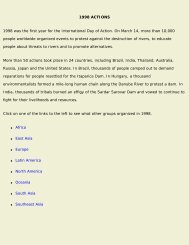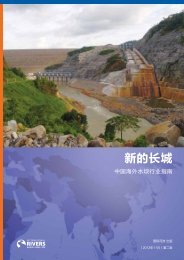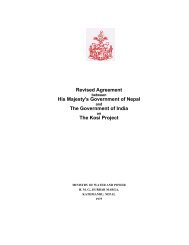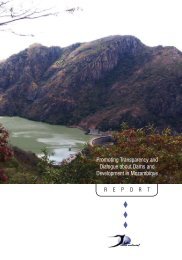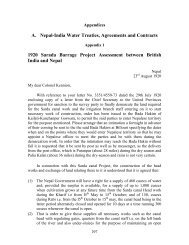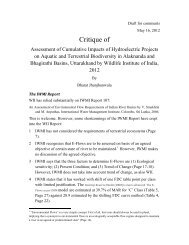Mountains of Concrete - International Rivers
Mountains of Concrete - International Rivers
Mountains of Concrete - International Rivers
You also want an ePaper? Increase the reach of your titles
YUMPU automatically turns print PDFs into web optimized ePapers that Google loves.
IntroductionThe Himalayas are the highest and among the most spectacularly beautiful mountains in the world. In the absence<strong>of</strong> a geographically precise definition, the Himalayas may be taken to mean the mountain ranges that separatethe Indian sub-continent from the Tibetan Plateau. By extension, it is also the name <strong>of</strong> the massive mountain systemwhich includes the Karakoram, the Hindu Kush, and a host <strong>of</strong> minor ranges extending from the Pamir Knot. 1The Himalayas consist <strong>of</strong> several parallel ranges runningwest to east, from the Indus River Valley to the BrahmaputraRiver Valley; they form an arc 2,400 kilometres long, whichvaries in width from 400 km in the western Kashmir-Xinjiang region to 150 km in the eastern Tibet-ArunachalPradesh region. 2 The Himalayas stretch across six countries:Bhutan, Nepal, India, Pakistan, China and Afghanistan.The Himalayas are undoubtedly a world heritage. All14 <strong>of</strong> the highest peaks in the world, called the “eightthousanders”(peaks with heights greater than 8,000 metres)are in the Himalayas. While UNESCO has declared theSagarmatha National Park near Mt. Everest in Nepal as aWorld Heritage Site, 3 there are hundreds <strong>of</strong> such undeclaredlocations <strong>of</strong> equal magnificence and significance in theHimalayas.The name itself literally means “the abode <strong>of</strong> snow,”and the Himalayan region is sometimes called the “ThirdPole,” as it has the most highly glaciated areas in the worldoutside <strong>of</strong> the two Polar regions. It has huge stocks <strong>of</strong> waterin the form <strong>of</strong> snow and ice, with a total area <strong>of</strong> 35,110km 2 <strong>of</strong> glacier and ice cover, and a total ice reserve <strong>of</strong> 3,735km 3 . 4 Hundreds <strong>of</strong> small and large rivers originate and runthrough the Himalayan region. It is the source <strong>of</strong> some <strong>of</strong>the largest rivers in Asia – the Indus, Ganga, Brahmaputra,and Irrawaddy – the basins <strong>of</strong> which are home to millions<strong>of</strong> people. Glacial and snow melt is an important source <strong>of</strong>the flows <strong>of</strong> these rivers. 5The rivers that originate in the Himalayas providesustenance, livelihoods and prosperity to millions <strong>of</strong> peopleliving in a vast area that stretches from the Indus Basin plains<strong>of</strong> Pakistan in the west to Bangladesh in the east. With theirhigh slopes and huge quantities <strong>of</strong> fast-moving waters, theHimalayan rivers have always been looked upon as havinglarge potential to generate hydroelectric power. Some <strong>of</strong>the earliest and largest hydropower stations in the countries<strong>of</strong> the Indian subcontinent have been built on Himalayanrivers; for example, the Bhakra Nangal project in India andthe Tarbela project in Pakistan.Recent years have seen a renewed push for buildingdams in the Himalayas. Massive plans are underway inPakistan, India, Nepal and Bhutan 6 to build several hundreddams in the region, with over 150,000 Megawatts (MW) <strong>of</strong>additional capacity proposed in the next 20 years in the fourThe Seti River near the planned West Seti Dam site in Nepal, 2007.The 750 MW West Seti project is set to begin construction even asthe affected people are strongly opposing it. Photo: Yuki Tanabecountries. If all the planned capacity expansion materialises,the Himalayan region could possibly have the highestconcentration <strong>of</strong> dams in the world.This dam building activity will fundamentally transformthe landscape, ecology and economy <strong>of</strong> the region and willhave far-reaching impacts all the way down to the riverdeltas. Submergence <strong>of</strong> lands, homes, fields and forests ona large scale will displace hundreds <strong>of</strong> thousands <strong>of</strong> people.Damming and diversion <strong>of</strong> rivers will severely disrupt thedownstream flows, impacting agriculture and fisheries andthreatening livelihoods <strong>of</strong> entire populations. Degradation<strong>of</strong> the natural surroundings and a massive influx <strong>of</strong> migrantworkers will have grave implications for the culture andidentity <strong>of</strong> local people, who are <strong>of</strong>ten distinct ethnic groupssmall in numbers. As the entire region is seismically active,<strong>Mountains</strong> <strong>of</strong> <strong>Concrete</strong>: Dam Building in the Himalayas | 3




